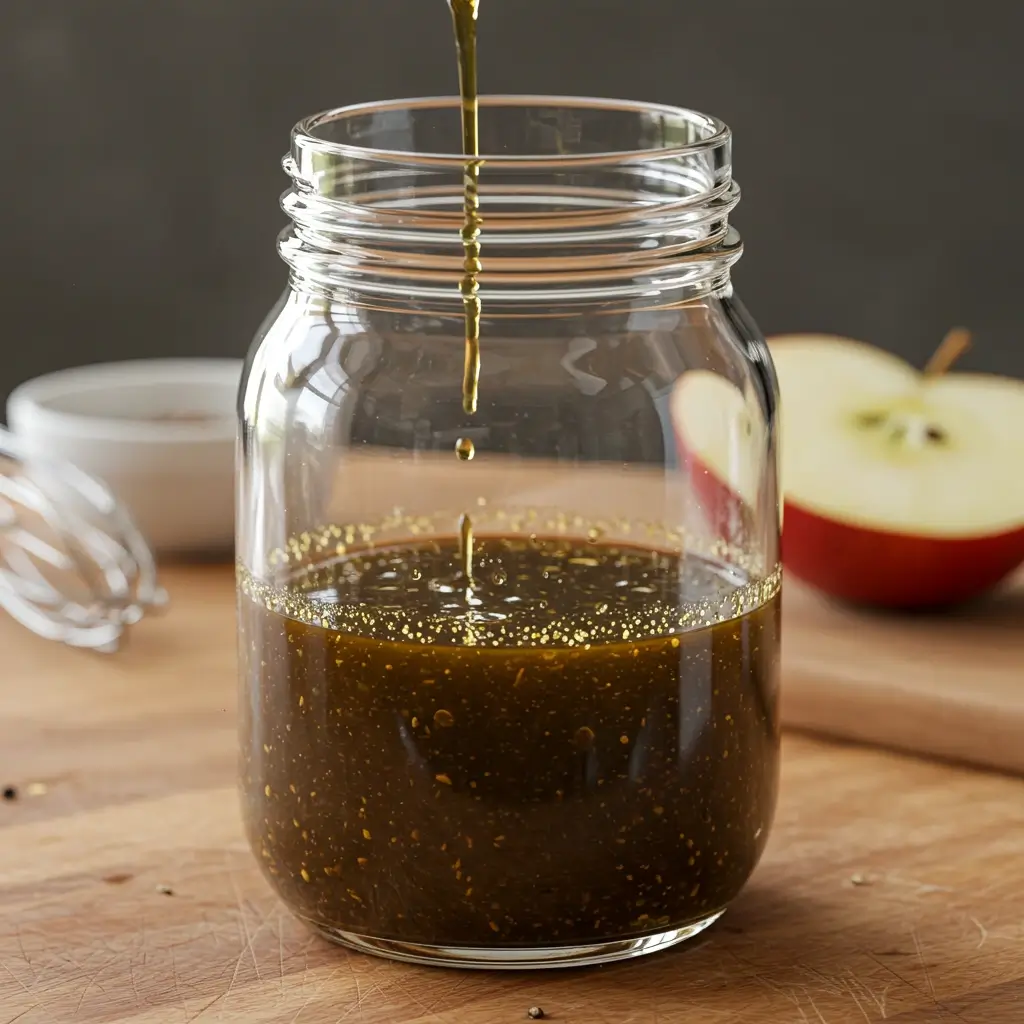Salad dressings can make or break a salad, and a well-prepared vinaigrette can elevate fresh greens to a gourmet experience. Among the myriad of dressing options, the red wine vinaigrette stands out for its tangy and robust flavor profile. This article delves into the art of making a classic red wine vinaigrette salad dressing, offering you an easy-to-follow recipe, nutritional insights, serving suggestions, and expert tips. Prepare to transform your salads into culinary masterpieces!
Ingredients for Red Wine Vinaigrette
To craft a delightful red wine vinaigrette, you’ll need a handful of simple yet flavorful ingredients. Here’s what you’ll need:
- 1/4 cup apple cider vinegar
- 1/2 cup olive oil
- 1 teaspoon Dijon mustard
- 1 teaspoon honey or maple syrup
- Salt and pepper to taste
These ingredients come together to create a balanced dressing that is both tangy and slightly sweet, with a smooth texture and a delightful depth of flavor.
Instructions: How to Make Red Wine Vinaigrette
Creating this delicious vinaigrette is a breeze. Follow these simple steps to prepare your own red wine vinaigrette:
- Combine Vinegar and Mustard: In a bowl, whisk together the apple cider vinegar, Dijon mustard, and honey until well blended.
- Emulsify the Oil: Slowly drizzle in the olive oil while whisking continuously to create a smooth emulsion. This step is crucial for achieving the perfect consistency.
- Season to Taste: Finish by seasoning with salt and pepper to taste. Adjust the seasoning based on your personal preference for a perfect balance of flavors.
With these straightforward steps, you can create a red wine vinaigrette that is ready to elevate any salad to gourmet status.
Nutrition Facts
Understanding the nutritional content of your dressing can help you incorporate it into your diet more effectively. Here are the nutrition facts per serving for this red wine vinaigrette:
- Calories: 90
- Fat: 10g
- Carbohydrates: 1g
- Sugar: 1g
- Protein: 0g
This vinaigrette is relatively low in calories, making it a healthy choice for those mindful of their intake. The olive oil provides healthy monounsaturated fats, while the vinegar and mustard contribute negligible carbs and sugars.
How to Serve Red Wine Vinaigrette
The versatility of red wine vinaigrette makes it a fantastic addition to a variety of dishes. Its tangy flavor profile, characterized by a balance of acidity and sweetness, can elevate the simplest of meals. Here are some serving suggestions that not only highlight the vinaigrette’s attributes but also inspire creativity in your culinary endeavors:
- Classic Green Salad Drizzle this vibrant vinaigrette over a bed of mixed greens, such as arugula, spinach, or romaine, topped with cherry tomatoes, cucumbers, and radishes. The dressing’s tanginess pairs beautifully with the fresh, crisp textures of the vegetables. For added depth, consider incorporating a variety of toppings such as toasted nuts (like walnuts or almonds) for crunch, crumbled cheese (like goat cheese or blue cheese) for creaminess, and seasonal fruits (like sliced pears or apples) for sweetness. To enhance presentation, serve the salad in a large, shallow bowl, allowing the vivid colors of the greens and toppings to shine through. Finish with a sprinkle of freshly cracked black pepper and a pinch of sea salt to elevate the flavors even further.
- Grain Bowls Enhance your grain bowls with this vinaigrette. Start with a base of hearty grains such as quinoa or farro, which not only provide a nutritious foundation but also absorb the vinaigrette beautifully. Layer in roasted vegetables like sweet potatoes, bell peppers, and Brussels sprouts, along with protein sources such as chickpeas or grilled chicken. Crumbled feta or goat cheese adds creaminess and a tangy kick that complements the vinaigrette. For a pop of color and flavor, incorporate fresh herbs like parsley or cilantro and a sprinkle of seeds (like pumpkin or sunflower seeds) for added texture. Drizzle the vinaigrette generously over the assembled bowl, and toss gently to ensure each ingredient is coated with the delicious dressing.
- Marinade for Proteins Use the red wine vinaigrette as a marinade for chicken, pork, or tofu. The acidity from the red wine and vinegar not only helps tenderize the protein but also infuses it with rich, complex flavors. For best results, marinate your protein for at least 30 minutes (or up to overnight) to allow the flavors to penetrate deeply. When using it for chicken or pork, consider grilling or roasting after marinating for a delightful char that adds an extra layer of flavor. If marinating tofu, press it beforehand to remove excess moisture, allowing it to soak up more of the dressing. After cooking, you can drizzle a little extra vinaigrette over the finished dish for a flavorful finish.
- Roasted Vegetables Toss roasted vegetables with the vinaigrette after cooking for a deliciously tangy side dish. Root vegetables like carrots and beets work particularly well, as their natural sweetness is beautifully complemented by the acidity of the vinaigrette. For a colorful medley, consider adding Brussels sprouts, cauliflower, or zucchini. Roast the vegetables until they are caramelized and tender, then while they are still warm, drizzle them with the vinaigrette and toss gently to coat. Allow the dish to sit for a few minutes to let the flavors meld before serving, which enhances the overall taste experience. Garnish with fresh herbs or a sprinkle of feta cheese for an added touch.
Additional Serving Tips
- Dipping Sauce: Use red wine vinaigrette as a flavorful dip for crusty bread or fresh vegetables. It pairs wonderfully with artisan loaves, pita chips, or an array of crudités, adding a zesty twist to a simple appetizer.
- Pizza or Flatbreads: Drizzle the vinaigrette over homemade or store-bought pizza or flatbreads. This can complement toppings like roasted garlic, fresh mozzarella, or sautéed greens, enhancing the overall flavor profile.
- Cold Pasta Salads: Incorporate red wine vinaigrette into cold pasta salads. Combine cooked pasta with a mix of vegetables, olives, and salami or grilled chicken, then toss with the vinaigrette for a refreshing meal. Chill before serving for a delightful picnic or potluck dish.
These serving suggestions demonstrate just how adaptable red wine vinaigrette can be, making it a must-have in your kitchen arsenal. Whether you’re dressing a salad, marinating proteins, or adding zing to roasted vegetables, this versatile vinaigrette is sure to impress your guests and enhance your everyday meals.
Additional Tips for Perfect Red Wine Vinaigrette
To take your vinaigrette to the next level, consider these additional tips that will not only enhance the flavor but also the overall experience of using this versatile dressing:
Use High-Quality Ingredients
The foundation of a delicious vinaigrette lies in its ingredients. When selecting olive oil, choose extra virgin olive oil (EVOO) as it is made from the first cold pressing of olives, preserving the robust flavors and health benefits. Look for oils that have a rich, fruity aroma and a vibrant green hue, as these characteristics often indicate freshness and quality. Similarly, when it comes to vinegar, opt for a high-quality red wine vinegar, which should have a balanced acidity and a complex flavor profile. Some gourmet brands offer vinegars infused with herbs or fruits that can add a unique twist to your vinaigrette.
Experiment with Flavors
One of the joys of making your own vinaigrette is the ability to customize it to your taste. Beyond the basic ingredients, consider adding minced garlic or shallots for a savory depth. Garlic can be used raw for a sharper bite or roasted for a milder, sweeter flavor. Fresh herbs such as basil, parsley, or tarragon can bring brightness and freshness to your dressing—experiment with different combinations to find your favorite. For those who enjoy a bit of heat, a pinch of red pepper flakes can add a subtle kick without overpowering the other flavors. Additionally, consider incorporating citrus zest or juice (like lemon or orange) for a refreshing twist that balances the acidity of the vinegar.
Adjust Consistency
The texture of your vinaigrette can greatly affect its application. If you prefer a thicker vinaigrette, consider increasing the amount of Dijon mustard; this not only thickens the dressing but also adds a creamy texture and enhances the flavor. Alternatively, if you desire a lighter, more pourable dressing, simply incorporate a bit more vinegar or a splash of water to achieve your desired consistency. Remember that the dressing will be more viscous when chilled, so adjust accordingly based on how you plan to use it.
Storage
Proper storage is key to maintaining the freshness of your vinaigrette. After preparing your vinaigrette, transfer any leftovers to a sealed container, preferably glass, to minimize any absorption of flavors from plastic. Store it in the refrigerator, where it can last up to a week. It’s important to note that, due to the oil and vinegar separation, your dressing will require a good whisk or shake before each use. If you find that the vinaigrette has thickened too much in the fridge, you can bring it back to life by letting it sit at room temperature for a few minutes before shaking.
Pairing Suggestions
To truly elevate your dining experience, think about how your red wine vinaigrette can complement various dishes. Use it to dress mixed greens, grain salads, or roasted vegetables. It also works wonderfully as a marinade for proteins like chicken, fish, or tofu, infusing them with flavor before cooking. Drizzling it over grilled vegetables or incorporating it into pasta salads can add a delightful zing that balances richer elements in your meal.
Mindful Pairing with Wines
When serving dishes dressed with red wine vinaigrette, consider the wine pairings as well. A light-bodied red wine, such as Pinot Noir, can harmonize beautifully with the vinaigrette’s acidity and enhance the overall meal experience. Alternatively, a refreshing white wine like Sauvignon Blanc can also work well, creating a delightful contrast with the rich flavors of the dressing.
By following these additional tips, you can create a red wine vinaigrette that not only enhances your dishes but also showcases your culinary creativity and personal taste. Whether you’re preparing a simple salad or an elaborate meal, this versatile dressing will add a burst of flavor that’s sure to impress.
FAQs About Red Wine Vinaigrette
Q: Can I substitute apple cider vinegar with red wine vinegar?
A: Absolutely! Using red wine vinegar will provide a more traditional flavor profile for the vinaigrette, although apple cider vinegar offers a unique twist.
Q: Is there a vegan alternative to honey?
A: Yes, you can use maple syrup as a vegan alternative to honey. It provides a similar sweetness and works well in this recipe.
Q: How can I make this vinaigrette lower in calories?
A: To reduce calories, you can use less olive oil and replace it with a tablespoon of water or chicken broth. This will alter the texture and flavor slightly but will reduce the calorie count.
Q: Can I use this dressing for pasta salads?
A: Definitely! This vinaigrette adds a wonderful tangy flavor to pasta salads, complementing ingredients like olives, tomatoes, and mozzarella.
Conclusion
Creating a homemade red wine vinaigrette is a simple yet rewarding culinary endeavor. With just a few ingredients and minimal prep time, you can craft a versatile dressing that enhances a wide range of dishes. The basic formula of vinegar, oil, and seasonings allows for endless customization, making it easy to adjust the flavors to your personal taste. Whether you’re drizzling it over fresh greens, using it as a marinade for meats, or dressing up roasted vegetables, this vinaigrette is sure to impress. The tangy acidity of the red wine vinegar pairs perfectly with the smoothness of olive oil, creating a balanced and flavorful dressing.
By experimenting with different ingredients and flavors, you can make the recipe your own. For a more intense flavor, try adding Dijon mustard or minced garlic. A touch of honey or maple syrup can bring a hint of sweetness, while fresh herbs like oregano or thyme will add an aromatic note. You can even incorporate a splash of lemon juice or balsamic vinegar for added complexity.
Once you master the basics, the possibilities are endless. This vinaigrette is a quick and easy way to elevate any dish, making it a delightful addition to your culinary repertoire. Embrace the art of vinaigrette-making and enjoy the delicious results. Bon appétit!
Print
Red Wine Vinaigrette Salad Dressing Recipe
Ingredients
- 1/4 cup apple cider vinegar
- 1/2 cup olive oil
- 1 teaspoon Dijon mustard
- 1 teaspoon honey or maple syrup
- Salt and pepper to taste
Instructions
- Combine Vinegar and Mustard: In a bowl, whisk together the apple cider vinegar, Dijon mustard, and honey until well blended.
- Emulsify the Oil: Slowly drizzle in the olive oil while whisking continuously to create a smooth emulsion. This step is crucial for achieving the perfect consistency.
- Season to Taste: Finish by seasoning with salt and pepper to taste. Adjust the seasoning based on your personal preference for a perfect balance of flavors.
Nutrition
- Serving Size: one normal portion
- Calories: 90
- Sugar: 1g
- Fat: 10g
- Carbohydrates: 1g
- Protein: 0g





